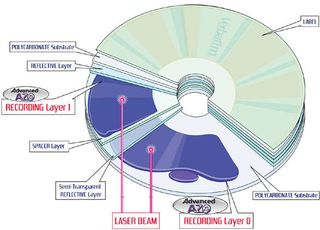Double-Layer DVD: Philips, LaCie, Asus and LG
Double-layer Media: Scarce And Expensive

Two different double-layer DVD blanks from Philips and Verbatim reached our laboratory.
Optically and size-wise, the double-layer generation does not stand out against other optical data media. Without a label, you wouldn't even be able to tell a CD from a DVD.
At least in the store, it is easy to tell the difference between a double-layer medium and any other DVD blank. The key is that it will set you back more than $15. Although the prices for DL banks will fall in the next few months, they will still cost several dollars per disc even in the run-up to Christmas. At these prices, it's worth doing the math first. Does it really have to be a DL blank or will two high-speed recordables with just 4.7 GB do the job too?
The reason for the high price of these media is not due to the manufacturer's business practices but to the comparatively high expense of production. The photo-polymerization technique used today means that it either takes double the time to produce a DVD+R DL blank, or more production lines are required than needed in single-layer manufacture. What's more, the yield has not yet reached 50% - in other words, every second disc is rejected. Although new techniques are in the pipeline, they won't be deployed until year-end.
Since the DL process is still in its infancy, the DVD+RW Alliance has initially limited it to a write speed of 2.4x. Thus, there has been a step backwards with regards to writing time - the burners from LaCie and Philips both take three-quarters of an hour, almost to the minute, for a full DVD+R9 with 8.5 GB.

The structure of a double-layer disc is good and clear.
Drives: Nothing New
Stay on the Cutting Edge
Join the experts who read Tom's Hardware for the inside track on enthusiast PC tech news — and have for over 25 years. We'll send breaking news and in-depth reviews of CPUs, GPUs, AI, maker hardware and more straight to your inbox.
In practice, manufacturers often have the opportunity to use existing drive designs and components for current and future models, sometimes in part and sometimes in all aspects. Thus the latest 16x burners to appear are largely based on components of the 8x models, explaining the minimal price differences. But it must be equally possible to make single-layer burners double-layer-compatible with a minimum of trouble. The optics are certainly capable of it as almost every DVD on sale today is a DVD9 - and they operate on two layers.
Current page: Double-layer Media: Scarce And Expensive
Prev Page The Proof Of The Pudding: CD-Rs Five Years On Next Page The Test Candidates In Detail